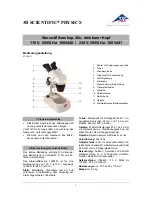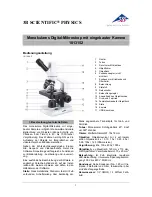
ZEISS
3 Product and Functional Description | 3.3 Optional Components and Accessories
Four channels are especially useful in combination with the program 3DSM, which provides a
topographical reconstruction of the specimen. The program 3DSM acquires four images of the
specimen and acquires each of these images with a different quadrant of the detector. This results
in four images from four different directions. With the BSD4 detector you can acquire these four
images all at once. An algorithm then calculates the topographic surface.
The BSD detector has a relatively large central hole and therefore has the advantage that it does
not limit the field of view of the SEM and does not influence the electron optical properties of the
objective lens. A disadvantage is that especially at low kV a lot of backscattered electrons are lost
in the central hole and cannot be detected. A solution for that is the aBSD detector.
Operating
Principle
On the surface of the specimen, some of the primary electrons are backscattered. The backscat-
tered electrons then move towards the silicon segments of the BSD detector. If the energy of the
backscattered electrons is high enough, then the electrons pass through the very thin dead layer
of the diode and create electron-hole pairs in the silicon segments.
In each individual segment, the charge separation due to the electron-hole pairs is measured as a
current, which is used as a signal for image generation. Only electrons that have a high enough
energy can create electron-hole pairs and can contribute to image generation. Electrons that have
a lower energy (e.g. secondary electrons) are not detected by the BSD detector.
The emission of backscattered electrons from a specimen is related to the atomic number of the
involved material: Elements with high atomic numbers generate more backscattered electrons (i.e.
the backscatter coefficient is higher). When imaging, regions that contain elements with higher
atomic numbers appear brighter. Regions that contain elements with lower atomic numbers ap-
pear darker.
Since the detector has a limited speed, it is recommended to use scan speed 6 or higher (slower),
especially at small magnifications. The lower the gain is, the faster is the detector.
3.3.1.4 aBSD Detector
Purpose
The aBSD detector is a pneumatically retractable annular backscattered electron detector. It is
used for high efficiency and angle selective material characterization even at low-kV applications.
It has six separate diode segments, two inner concentric rings and four outer quadrants. The inner
segments provide mostly material contrast whereas the four outer quadrants provide more topo-
graphical contrast.
Fig. 21: The
detector with two inner concentric segments and four outer quadrants
NOTICE
Risk of property damage: Motorized specimen stage
Risk of damaging the detector when operating the motorized specimen stage.
4
Retract the detector head completely after you have finished the work with the detector.
Instruction Manual ZEISS Crossbeam 550L, Crossbeam 550 | en-US | Rev. 3 | 349500-8122-000
47
Содержание Crossbeam 550
Страница 135: ......
















































